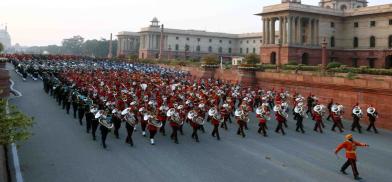Indian military bands whip up patriotic fervour with their entrancing musical repertoire
Over the decades since the 1950s many Indian Armed Forces band masters composed numbers based on Indian folk music sourced from different parts of the country. After almost five decades, there has been slow phase-out of Western tunes and more works by Indian composers, many of whom are from within the armed forces themselves.

The front stretch of Mumbai’s historic Gateway of India got filled with a few thousands Mumbaikars who gathered there on 15 August 2025, India’s 79th Independence Day, 202 to attend the performance of the joint Army and Navy Band. The iconic Gateway was constructed during British rule as a ceremonial entrance to India and is the very site from where the last of their troops departed in 1948. While performances by military bands for the public at the same site every year draw a fair crowd, this time the gathering seemed larger than usual - possibly in a show of strong patriotic support for the armed forces in the wake of Operation Sindoor, the Indian military operation against Pakistan in retaliation for the killing of 26 Indian travellers in Jammu and Kashmir which New Delhi blamed on Pakistan-supported terrorists. A large poster of the Op Sindoor was part of the backdrop on the stage set up for the Band.
The Army-Navy Band’s joint performance filled the air with stirring martial music including evergreen melodies like Vande Mataram, Mera Mulk Mera Desh, Teri Mitti Mein Mil Jaawaan, Kandhon se Milte hain Kandhey, Jai Bharti, Kadam Kadam Badhaye Ja and, the ever popular, Saare Jahaan Se Achhaa. A mood of engaged patriotism was evident from the sustained applause from the assembly after every number.
Legacy of Colonial Era
When the British began training Indian soldiers to play military music on Western musical instruments, they were not aware that for every category of Western musical instruments there was an Indian counterpart. It therefore did not take long for Indian military musicians to learn English military tunes/compositions on Western musical instruments. The British East India Company, and later the British Indian Army, established military bands which originally played Western classical pieces, marches, and popular tunes.
The two types of military bands instituted in the India’s Armed Forces were pipes and drums and brass bands. First came the brass bands which were introduced in native regiments of the East India Company in the early 19th century to foster an appreciation in Indians for Western music. By the late 19th century, pipes and drums bands were introduced into British Indian Army’s regiments. Since then, each infantry battalion of the Indian Army has its own pipes and drums band. Marching tunes were meant to keep soldiers in step during drills and marches.
Before India's Independence, Indian army brass bands predominantly played Western classical and military music, including marches and popular tunes of the time. After Independence gradually, bands started incorporating Indian folk, classical, and patriotic tunes into their repertoire. This blend of musical symphonies aimed to create a unique identity for the bands and foster a sense of national pride for their listeners, both soldiers and citizens.
Indianisation of Military Music
Post Independence a need was felt to establish an Indian institution of military music to give a new direction and dimension to the music of the Indian Armed Forces. On 23 October 1950, under the patronage and supervision of General K. M. Cariappa, the-then first Indian Commander-in-Chief of the Army, Major G.A. Roberts, the Advisor of Military Music at Army Headquarters, New Delhi established the Military Music Wing as part of the Army Education Corps at Pachmarhi, Madhya Pradesh. Also in 1950, Major Roberts played a key role in shaping the Beating Retreat ceremony, held at Vijay Chowk, Raisina Hill in the governance hub of New Delhi.
The Military Music Wing provides instruction to musicians of all ranks. Most senior military bands can be configured from a marching band to a concert band and can also form smaller ensembles to jazz ensembles, traditional music bands, brass quintets, woodwind and drumlines. A general military band consists of a band master and 33 musicians while a pipe band consists of a band master and 17 musicians. Bandsmen in the Indian Army are soldiers first, having the primary role in battle of medical assistants.
Today, the Indian Armed Forces have more than 50 military brass bands and 400 pipes and drums bands. Each of the three services - Army, Navy, and Air Force - maintains its own distinct military bands. For certain occasions like Beating Retreat a tri-service band joint military band is formed which performs together as a unit.
Over the decades since the 1950s many Indian Armed Forces band masters composed numbers based on Indian folk music sourced from different parts of the country. After almost five decades, there has been slow phase-out of Western tunes and more works by Indian composers, many of whom are from within the armed forces themselves. Tunes like "Veer Bharat," "Amar Senani," "INS Vikrant," and "Priyadarshini" reflect the Indian voice and are composed by military musicians. Ram Singh Thakuri, a well-known composer who served in the Indian National Army (INA), later founded the Constabulary band. Lieutenant Manjit Singh Neer, a clarinet player of the Indian Naval Band composed a piece based on a classical Indian raag, Lalit, which became very popular. Over 200 such tunes are now in use for different functions and ceremonies, with new ones being created. Instruments like the mridangam, tabla, santoor, sitar, and jal tarang have been added to military ensembles and are well received by audiences.
General Shankar Roychowdhury, during his tenure as the Chief of the Army Staff (1994-1997), personally instructed that the INA’s patriotic song and the regimental quick march, "Kadam Kadam Badhaye Ja" be included into the Indian Army's repertoire of marching tunes.
Indian military bands are regularly invited to participate and perform in foreign countries at international military music festivals, tattoos, and other events. Their participation is considered regular and significant, reflecting their high level of professionalism and the Indian military's commitment to cultural exchange and diplomacy.
India held its first ever military music festival in March 2010, when military bands from six countries cast a spell over audiences in Delhi at the Army Parade Ground, Purana Qila and India Gate. The bands participating were from France, Britain, Bangladesh, Sri Lanka, Nepal and from India, which was represented by bands from Indian Army, Navy and Air Force. Besides armed forces bands, Kalaripayattu (traditional martial art of Kerala), Bhangra, Ladakhi dance and Maharashtra’s Lezim dance performed by soldiers also captivated audiences.
A notable change since 2022 was that the traditional hymn "Abide With Me" played at the end of the Beating Retreat ceremony was replaced by the haunting song "Aye Mere Watan Ke Logon", sung by Lata Mangeshkar. This was part of a broader initiative to remove "colonial elements" and include only Indian songs at official ceremonies. The Beating Retreat, a military music parade instituted in 1950, has undergone some changes in recent years which mar the solemnity which such a parade must have. These changes, as seen since the 2018 version, stand out as deviations, too jarring and totally out of place, leaving the large community of armed forces veterans and serving personnel seething with indignation.
Central Armed Police Forces, very often wrongly referred to as para military forces, i.e. Border Security Force (BSF), Central Industrial Security Force (CISF), Central Reserve Police Force (CRPF), Indo-Tibetan Border Police (ITBP) and Sashastra Seema Bal (SSB) as well as state police forces, have their own brass bands.
Horse and Camel-Mounted Bands
It will be interesting to know that the Central India Horse (CIH), a cavalry regiment of the British Indian Army and now part of the Indian Army’s Armoured Corps, maintained a horse- mounted band in till about 1940 when the Indian Cavalry converted to battle tanks.
The BSF, which has a camel battalion of the erstwhile Ganga Jaisalmer Risala and later 13 Grenadiers, has a camel mounted band, which performs during Republic Day and Beating Retreat.
Bagpipe music has caught the fancy of Indians and has become popular in some parts of the country. One of them is in the mountainous region of Garhwal in Uttarakhand, where bagpipers are proud members of civilian bands requisitioned for weddings. Bagpipes sounds are produced through reeds as are some traditional Indian instruments like the ‘shehnai’ famously used in Indian classical music and during weddings as well as the ‘been’, played by traditional snake-charmers.
Indian military bands are quite often requested for by the Russian Embassy in New Delhi for important functions held there. Most of the numbers played by these bands are of old Raj Kapoor's movie songs, much to the pleasure of the Russian diplomats and their guests. It is unlikely US President Donald Trump would be aware of this old Indo-Russian cultural connect when he disparages traditional India-Russia ties.
(The author is a strategic affairs analyst and former spokesperson for the Ministry of Defense and the Indian Army. Views expressed are personal. He can be reached at wordsword02@gmail.com | LinkedIn | X/Twitter: @ColAnilBhat8252)









Post a Comment